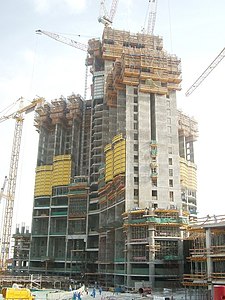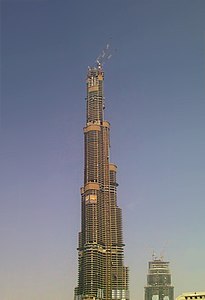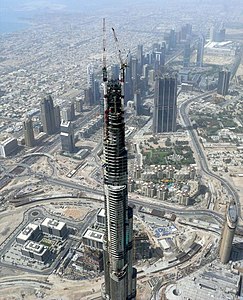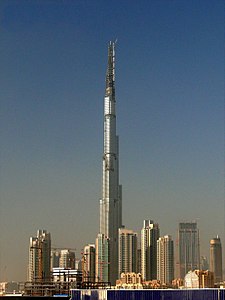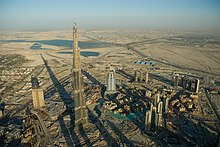Burj Khalifa
| Burj Khalifa | |
|---|---|

|
|
| Basic data | |
| Place: |
Dubai , United Arab Emirates |
| Construction time : | 2004-2010 |
| Opening: | January 4, 2010 |
| Status : | Built |
| Architect : | Adrian Smith of Skidmore, Owings and Merrill |
| Use / legal | |
| Usage : | Apartments, hotels, offices |
| Owner : | Emaar Properties |
| Technical specifications | |
| Height : | 828 m |
| Height to the top: | 829.8 m |
| Top floor: | 638 m on the highest floor accessible by elevator (technology); according to CTBUH criteria: 584.5 m |
| Rank (height) : | 1st place (world) |
| Floors : | Usable: 163 Total: 189 |
| Elevators : | 57 |
| Floor area : | 517,240 m² |
| Building material : | Construction: reinforced concrete , steel. Facade: aluminum , glass |
| Building-costs: | approx. 1 billion euros (1.5 billion US $) |
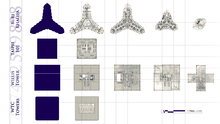
The Burj Khalifa ( Arabic برج خليفة, DMG Burǧ Ḫalīfa 'Chalifa Tower', German transcription Burj Chalifa ) is a skyscraper in Dubai ( United Arab Emirates ). Until the inauguration, the building was called Burj Dubai ( Arabic برج دبي 'Dubai Tower'), since then it has been named after the President of the United Arab Emirates Chalifa bin Zayid Al Nahyan .
The Burj Khalifa was built by the project company Emaar Properties according to plans by the architect Adrian Smith from the American architecture firm Skidmore, Owings and Merrill . Since April 2008 it has been the tallest building in the world , has the most floors in the world and the highest usable floor. Construction work began in 2004, and in January 2009 the final height of 828 meters was reached. The building was inaugurated on January 4, 2010.
location
Due to its size, the Burj Khalifa has become the center of a new urban development area called Downtown Dubai . A wide mix of different functions such as retail, housing, offices, hotels, shopping, entertainment and leisure have been brought together here and have invested US $ 20 billion over the past few years .
use
The world's first Armani Hotel has moved into the lower 38 of the 163 generally usable floors. On the floors above there are 43 offices and some suites .
The 124/125. The second floor is designed as a viewing platform at a height of 456 meters with a 360-degree view of “At the Top, Burj Khalifa”. The flow of visitors is transported to the 124th floor in 55 seconds by 2 elevators. Since autumn 2014, another viewing platform “At the Top, Burj Khalifa SKY” has been available to visitors. An elevator first takes visitors to the 124th floor, another elevator then takes visitors up to the 148th floor to a viewing platform with an outside terrace at 555 meters. It is designed a bit more exclusively, drinks and snacks are served. The rush of visitors is much lower on the 148th floor than on the 124th/125. Floor. Both terraces (124th, 125th and 148th floor) are aligned so that you have a good view of the “ Dubai Fountain ”, which starts daily at 6:00 p.m., but the one on the 148th floor does not offer 360 Degree all-round view.
In January 2011, the @mosphere restaurant belonging to the Armani Hotel was opened on the 123rd floor , which is the highest restaurant in the world in terms of the number of floors below.
The highest inhabited floor is the 163rd and is 584 meters.
Elevators lead to the 189th floor at 638 meters.
In February 2011, two gold vending machines in the Burj Khalifa was opened, where you like at a cash machine , gold ingots of up to one ounce can pick up.
Due to falling demand in Dubai, apartment prices in the Burj Khalifa have fallen by 40 percent ten months after opening. In October 2010, 825 of 900 apartments were vacant.
classification
The investors kept both the height of the tower secret until the opening on January 4, 2010 and the number of floors. On January 17, 2009, the Burj Khalifa reached its final building height of 828 meters. With a total height of 829.8 meters including the railing and light signal system (according to Helge Sobik: antenna ) on the top of the tower and at least 189 floors (163 of which are usable), the Burj Khalifa is both the tallest building to date and the tallest structure in the world. It is the building with the highest floor in use, has the highest roof and the highest viewing platform. It towers above the Taipei 101 (508 meters) as the tallest building to date (height of the building structure), the Willis Tower (formerly Sears Tower) in Chicago (527 meters) as the absolutely tallest building (height to the top of the antenna) and the CN Tower (553 Meters) in Toronto as the tallest non-guyed structure to date. For the first time since the Empire State Building was erected in 1931 , the above-mentioned records for the tallest structure have been awarded to a single building. The Burj Khalifa is also the world's tallest building that is also used for residential purposes.
A competitor for the title of the tallest building in the world was to be built twelve kilometers from the Burj Khalifa: the Nakheel Tower (formerly known as Al Burj ) was planned to be at least 1,000 meters high. At the height of the real estate bubble, the tower commissioned by Nakheel Properties was even supposed to double the height of the Burj Khalifa from competing construction company Emaar Properties. Due to the global financial crisis , the preparatory work on the Nakheel Tower was stopped in March 2009.
The top of the building can be seen from a distance of over 100 kilometers when the view is clear.
Technical specifications
The Burj Khalifa has a floor area of 526,760 square meters; the usable area is approx. 517,000 square meters. A total of 330,000 cubic meters of concrete , steel and other materials were required for the construction . A few thousand tons of steel on the upper floors are recycled steel from the demolished Palace of the Republic in Berlin. Because of its great height, the tower's deflection on the highest floors is around 1.5 meters in wind - but the building does not need a vibration absorber .
Around 200 large and 650 small concrete piles were driven into the ground for the construction of the Burj Khalifa, reaching a depth of around 70 meters below sea level. These ensure that only a small part of the otherwise far too strong pressure forces of the tower are diverted via the foundation base, while the main part is absorbed by physical friction via the surface of the concrete piles. For the air conditioning of the high-rise building in a desert region, 60 air ducts are installed, which act like chimneys in the opposite direction, i.e. from top to bottom ( hot climate stack effect ). In return, hot and accelerated air must be extracted around the clock against the overpressure.
The tower was erected in a total of 22,000,000 working hours. At peak times, 12,000 workers worked on the construction.
Officially there are 163 usable floors, of which 49 floors are used for offices and 4 floors for the fitness and wellness area. Floors 158 to 162 are available to Mohammed Ali Alabbar, CEO of Emaar Properties , as personal office space and mosque . The remaining floors house 1044 apartments , 144 of which are residences in Armani Residences Dubai . The top 8 floors up to the top of the building with a diameter of 1.20 meters can only be reached via a narrow staircase. They contain switch boxes and the maintenance electronics of the antenna, with which the tower comes to a total height of 829.8 meters.
The Burj Khalifa is accessed by 57 elevators and 8 escalators . The main elevators in the building are hoisted 504 meters - more than any other high-rise in the world. Two double-deck elevators lead exclusively to a viewing platform on the 124th floor at a height of 452 meters. Together with the double-deck elevators in the Shanghai World Financial Center , they are among the fastest double-deck elevators in the world with a speed of 10 meters per second (36 km / h). The world's highest elevator stop with a height of 638 meters is in the Burj Khalifa.
Two additional viewing platforms have been accessible since autumn 2014, a platform without an outside terrace on the 125th floor and a platform with an outside terrace on the 148th floor at 555.70 meters. This is the world's highest publicly accessible viewing platform. A total of 2,909 steps lead from the ground to the 160th floor.
The parking garage on the two floors below the building (B1 and B2) has 3000 parking spaces. With the Dubai Fountain , the largest water feature in the world was created in Downtown Dubai in front of the Burj Khalifa . In Lake Dubai, a water feature over a length of 250 meters can create up to 1000 different water impressions with heights between 21 and 150 meters.
architecture
As with most of the tallest buildings of their time, a novel process was used for the Burj Khalifa. There are three building pillars on a Y-shaped floor plan , which support one another by being brought together in the central axis, like a wind turbine. A hexagonal axis in the center of the tower makes it very stable against twisting . The chief engineer and inventor William F. Baker calls this buttressed core ('supported core').
When construction began, it was not yet clear how high the tower could be. Initially, it was supposed to be only slightly higher than the tallest building on earth, Taipei 101 with a height of 508 meters. After the foundation was poured, it turned out that a much higher construction method is possible. Even during the advanced construction of the reinforced concrete core, the height of this core was corrected upwards several times from the originally planned 507 to the most recently 601 meters.
Construction work
- Construction phases
In February 2004, the preparatory work for the foundation began. This included extensive pile tests, including a load test with a mass of 6,000 tons. At the end of April 2004, construction of the actual pile foundation began. This was completed in the area of the tower in mid-July 2004. The piles were built by Dubai-based companies Middle East Foundations Group ( MEFG ) and Bauer Spezialtiefbau as subcontractors under the supervision of Turner , Hyder Consulting and specialists from Skidmore, Owings & Merrill ( SOM ). The building is founded on a 7,000 square meter, 3.7 meter thick foundation plate made of 12,500 cubic meters of reinforced concrete. 200 concrete piles with a diameter of 1.5 meters and a length of 50 meters each and 650 piles with a diameter of 0.9 meters and a length of 36 meters to a depth of around 70 meters below sea level are arranged under the slab. A total of 45,000 cubic meters of concrete with a mass of 110,000 tons were used for the foundation alone . On December 10, 2004 the decision was made as to who will implement the project. An international consortium led by the South Korean company Samsung and the Chicago architects' office Skidmore, Owings & Merrill began building work in early 2005. The building itself was designed by Adrian Smith, then still employed by SOM . The architecture firm has already designed a number of well-known skyscrapers such as the Sears Tower in Chicago (1974), the Jin Mao Tower in Shanghai (1998) and the One World Trade Center at Ground Zero .
The construction work took place in three shifts with around 2,400 people around the clock. Because of the heat during the day, concreting was almost only possible at night. The construction site was bathed in glistening artificial light at night and was visible from afar. Another floor was added about every four days, and in the upper areas even every three to four days. Up to and including the 160th floor at a height of 601 meters above the foundation, the building was constructed as a reinforced concrete construction , the rest of the central tower was constructed as a steel construction. On November 9th 2007 the climbing formwork of the concrete structure was removed. The construction manager was the New Zealand engineer Greg Sang.
On Christmas Eve 2006, the Burj Dubai (since opening: Burj Khalifa ) became the tallest structure in Dubai and overtook the 355-meter-high Emirates Office Tower . At the turn of the year 2006/2007, the Burj Dubai broke the 100-story mark. The construction site hit the headlines in March 2006 when some 2,500 construction workers , earning just US $ 4 to 8 a day, went on strike to demand higher wages and benefits , destroying site and office facilities in the process. According to official information, they caused a million US dollars in damage. Because only the surrounding buildings were on strike, the construction of the tower was not delayed either.
In mid-November 2006, unavailable facade elements endangered the strictly scheduled construction process. The reason for this was the bankruptcy of the Swiss manufacturer Schmidlin, who was commissioned with the delivery and installation of the facade . The VAE joint venture subsidiary of the group was taken over by an Arab construction company which, according to its own statements, had already started manufacturing the elements in November 2006. The assembly of the facade elements started in mid-May 2007. By the beginning of February 2008, 12,000 facade elements had been installed; about 50 percent of the planned amount. By November 2008, around 180 floors were covered with it.
On September 30, 2009, the investor announced that the last part of the facade, at a height of 632 meters, had been completed with the facade of the skyscraper clad with glass and stainless steel of quality 1.4404 and the pattern SM-5WL. A total of 24,380 facade parts in 200 different sizes were installed in around 28 months of construction. They cover an area of 132,190 square meters, plus 103,000 square meters of glass. The aluminum facade parts alone weigh five empty Airbus A380s (approx. 1,375 tonnes), and 2,052 kilometers of seals were used to seal the facade against moisture and fine dust .
Initially three, later two more luffing jib cranes , which were anchored in the tower core and self- climbing, were used as cranes .
180,000 cubic meters of concrete were used for the tower and the wings. 165,000 cubic meters of it were pumped up, most recently to a height of 606 meters. For the construction of the Burj Khalifa , high-strength concrete of strength classes C60 and C80 was used for the walls of the central core and C50 for the floor slabs. This ready-mix concrete, which has been treated with special chemicals, has a compressive strength three times higher than that of concrete with normal strength. Concreting was only done at night, otherwise the fresh concrete would have been damaged due to the high daytime temperatures of up to 50 ° C. The ready-to-use liquid concrete was transported to the respective working height with high-performance concrete pumps from Putzmeister . They pumped the concrete at a maximum theoretical pressure of up to 400 bar and at 30 cubic meters per hour up to 606 meters high. As a pumping aid, two cubic meters of slurry, an aqueous concrete mixture, was first transported upwards, collected, and then brought back down with a crane. The concrete requirement for each section was 100 cubic meters for the building core and 150 to 50 cubic meters for the ceilings, decreasing with height. Since the time of the concrete in the riser at the originally planned approx. 570 meters (reached around the end of September 2007, later increased to 601 meters and finally to 606 meters pumping height) and the DN 150 pump line used was up to 40 minutes, the high-performance concrete but already after 2 hours with hardening, a quick emptying of the riser, the so-called "iron sword", similar to a hydraulic slide, had to be constructed in case of an emergency, in order not to lose the entire pipe run through hardened concrete. The weight of the filled delivery line was up to 50 tons, of which the contents of 26 tons weighed hydraulically on the concrete pump. The delivery line was held on supports that were welded to steel plates set in concrete. The three-meter-long pipes of the pump line were fixed with ceiling brackets. This enabled the pipes to move vertically, but prevented them from breaking out horizontally, i.e. from kinking. More than 30 German mainly medium-sized companies were also significantly involved in the construction of the tower or as a supplier.
The construction costs of around 1.5 billion US dollars were originally intended to be financed by the royal family of Dubai alone - without any loan . However, the investor was also affected by the financial crisis, so that at the last minute the eponymous Sheikh Chalifa bin Zayid Al Nahyan of Abu Dhabi stepped in with a “cash injection” to secure the completion of the tower. The building opened on January 4, 2010.
chronology
- September 21, 2004: Construction work began.
- May 13, 2007: The concrete used in the construction was pumped 452 meters higher than ever before.
- July 21, 2007: The structure exceeded the height of 508 meters high Taipei 101 .
- August 12, 2007: The tower known at the time as Burj Dubai towered over the top of the antenna of the 527-meter-high Sears Tower , which was the highest building in terms of total height.
- September 12, 2007: With a height of 555 meters, the shell exceeded the CN Tower as the tallest non-guyed structure on earth.
- November 8, 2007: The reinforced concrete core was completed with 601 meters above the foundation.
- April 7, 2008: After the Burj Dubai reached 629 meters, it became the tallest structure on earth and replaced the KVLY mast in North Dakota .
- September 1, 2008: The height of 688 meters was exceeded. The structure exceeded the radio mast (646 meters) which collapsed in 1991 and has been the tallest structure ever erected in the world.
- January 17, 2009: The final, official height of 828 meters has been reached.
- October 1, 2009: Emaar Properties announced the completion of the structural work and January 2010 as the opening date.
- January 4th 2010: Inauguration and naming after the ruler of Abu Dhabi and President of the United Arab Emirates, Sheikh Chalifa bin Zayid Al Nahyan .
- January 5, 2010: One day after the inauguration, two base jumpers jumped from the Burj Khalifa. With a jump height of 672 meters, this is a new world record. The maximum speed in flight was 220 km / h, the flight time 1.5 minutes.
- April 27, 2010: Opening of the Armani Hotel
- March 29, 2011: The French extreme climber Alain Robert, known as Spiderman, climbed the building in a good six hours.
- May 10, 2011: First officially announced suicide on the Burj Khalifa when a 30-year-old Indian fell from the 147th floor. He hit the restaurant terrace on the 108th floor and was instantly dead.
logistics
Every 20th floor of the skyscraper is used for building logistics . 54 elevators connect the floors, the fastest of which - a double-decker elevator with a speed of up to 10 m / s (36 km / h) - takes about 55 seconds for the distance of 500 meters.
The average water requirement is given as 946 cubic meters per day and the daily electrical peak load value with values between 36 and 50 megawatts.
Floor use
The following table shows the usage and, if known, the height of the floors, including the data from the sources.
| Floors | Floor height in m (above the ground) |
use | Floor occupancy |
|---|---|---|---|
| 160 and higher | from 621.30 | Technical floor, switch boxes, maintenance electronics of the antenna |

|
| 156-159 | Telecommunication systems | ||
| 155 | 589.30 | Technical floor | |
| 149-154 | offices | ||
| 148 | 555.70 | Viewing platform with outdoor terrace At The Top / Sky |
|
| 139-147 | offices | ||
| 136-138 | Technical floor | ||
| 126-135 | offices | ||
| 124-125 | 452.10-456 | Viewing platforms with outside terrace on 124 At The Top |
|
| 122-123 | 441.30-446.10 | Sky lobby and restaurant @mosphere | |
| 111-121 | offices | ||
| 109-110 | Technical floor | ||
| 77-108 | Apartments | ||
| 76 | 271.30 | Sky lobby | |
| 73-75 | Technical floor | ||
| 44-72 | Apartments | ||
| 43 | 162.30 | Sky lobby | |
| 40-42 | Technical floor | ||
| 38-39 | Armani Hotel Suites | ||
| 19-37 | Armani residences | ||
| 17-18 | Technical floor | ||
| 9-16 | Armani residences | ||
| 1-8 | Armani Hotel | ||
| ground floor | 10.00 | lobby | |
| Concourse | 4.00 | Boutique office lobby , parking spaces | |
| B1-B2 | −3.20 | Parking spaces, technical floor |
reception
A central part of the film Mission: Impossible - Phantom Protocol takes place in the Burj Khalifa and in its surroundings. Accordingly, its premiere also took place in Dubai.
The future of the building and its eventual destruction after a fictional disappearance of mankind is shown in episode 5 of the 2nd season of the docu-fiction series Future Without People (“Collapse Risk”, USA 2010).
On 22 March 2019, the owners projected the likeness of New Zealand Prime Minister Jacinda Ardern gratitude for their sympathy with the Muslim world after the attacks on two mosques in Christchurch and Linwood on the building.
See also
- List of tallest structures in the world
- List of tallest buildings in the world
- List of the tallest buildings of their time
- List of tallest buildings in Dubai
- List of tallest buildings in Asia
- List of tallest buildings in the Middle East
literature
- Gerhard Blaasch: The height is still in the fog . In: Civil engineering . No. 2 , 2007, p. 66–77 ( online article (PDF, approx. 940 kByte) [accessed on January 7, 2010]).
- Gerhard Blaasch: A city above the city . In: Deutsches IngenieurBlatt . No. 6-7 , 2007, pp. 18-31 .
- Gerhard Blaasch: Dubai - Eldorado for builders . In: Civil engineering . No. 4 , 2008, p. 190–198 ( online article (PDF, approx. 2.2 MByte) [accessed on January 7, 2010]).
- Gerhard Martin Burs: Media Presentation in Contemporary Architecture: The Example of the United Arab Emirates. Transcript, Bielefeld 2016, ISBN 978-3-8376-3343-6 , pp. 227-273.
Web links
- Burj Khalifa - Official Website (English)
- Imre Solt's diary about construction progress with many pictures (English)
- Video with a view from the top of the building on YouTube (English)
Remarks
- ↑ With an earth diameter at the equator of 12,756.320 km (half of which is equal to the radius ), an equatorial circumference of 40,075.017 km and the maximum building height mentioned , according to the definition of the cosine on the right triangle, there is an angle between observer on the ground, Center of the earth and spire . This angle share of a full circle times the earth's circumference gives the distance to the ground from the tower base to the observer location from which you can just see the spire still: . It is easier according to Pythagoras (right triangle). The maximum straight line distance from the observer to the top of the tower is calculated.
Individual evidence
- ↑ a b c d e f g h i j k l Burj Khalifa , ctbuh.org
- ↑ a b c d e f g h OTIS systems in the tallest building in the world - the Burj Khalifa in Dubai ( Memento from March 4, 2016 in the Internet Archive ), otis.com, January 2010. Retrieved on February 12, 2010.
- ↑ Carsten Kühntopp: Tallest building in Dubai inaugurated - the Caliph's tower towers over them all ( Memento from January 7, 2010 in the Internet Archive ), Tagesschau .de, January 4, 2010.
- ↑ Burj Khalifa dining reaches new heights , on gulfnews.com
- ↑ Dubai: Pick up gold at the gold machine in the Burj Khalifa ( memento from January 14, 2013 in the Internet Archive ), accessed on February 11, 2013.
- ↑ Burj Khalifa rents tumble 40% , on thenational.ae
- ↑ Burj Khalifa sees a further drop in apartment rents. Retrieved February 18, 2020 .
- ↑ Burj Khalifa / Burj Dubai - The World's Tallest Skyscraper - Dubai, United Arab Emirates , on burjdubaiskyscraper.com
- ↑ a b c d Helge Sobik: Burj-Chalifa construction manager - The skyscraper man . In: Spiegel online, January 7, 2010. Retrieved February 13, 2010.
- ↑ a b Glass, Steel and Stone: The Burj Khalifa ( Memento from January 3, 2010 in the Internet Archive )
- ^ Burj Dubai. Emporis, accessed May 4, 2009 .
- ↑ Dubai Plans 1140 Meter Tall Tower , Skyscrapernews.com, October 6, 2008, accessed October 7, 2008.
- ^ Nakheel Tower , Skyscraper Page
- ↑ a b Top 10 Burj Khalifa facts, part 2 , ConstructionWeek, January 5, 2010.
- ↑ Spiegel Online: Recycled materials in the VW Golf VI - DDR inside
- ↑ a b c d e nextroom : Burj Dubai - Operation Desert Tower . In: The Standard . January 9, 2010. Accessed March 20, 2010.
- ↑ Michael Vogel: Put a damper on skyscrapers. (PDF; 995 kB) In: Physik Journal . August 2015, accessed on December 8, 2019 (Edition 14, 2015, No. 8/9, p. 78 f.).
- ↑ a b c d Top 10 Burj Khalifa facts , ConstructionWeek, December 28, 2009.
- ^ Emaar Rises With Mohamed Bin Ali Alabbar's Inspired Leadership ( January 22, 2010 memento on the Internet Archive ), Dinar Standard, January 26, 2008. Retrieved March 21, 2010.
- ↑ Live from Burj Khalifa ceremony , ArabianBusiness.com, January 4, 2010.
- ↑ a b Photo: Foundation of the Burj Dubai on the right in the foreground (JPG), die-wolkenkratzer.de, accessed on June 11, 2009.
- ↑ Carsten Kühntopp, ARD radio studio Amman: The tallest building in Dubai inaugurated - the Caliph's tower towers over them all ( Memento from January 7, 2010 in the Internet Archive ). In: Tagesschau.de on January 4, 2010. Retrieved on March 20, 2010.
- ↑ a b c High concrete pumping at Burj Dubai ( Memento from January 8, 2010 in the Internet Archive ), press release, Putzmeister AG, May 4, 2007. Accessed on March 18, 2010.
- ↑ a b 601 m pump height at Burj Dubai - and it goes on! ( Memento of March 25, 2010 in the Internet Archive ), press release, Putzmeister AG, November 21, 2007. Accessed on March 18, 2010.
- ↑ a b World record pumping height at Burj Dubai - 606 meters ( Memento from December 9, 2009 in the Internet Archive ), press release, Putzmeister AG, April 17, 2008. Accessed on March 18, 2010.
- ↑ a b c d World record with Doka formwork technology. Retrieved February 18, 2020 . bauforum.at, November 15, 2007.
- ^ A b Structural Elements - Elevators, Spire, and More . Retrieved February 18, 2020 . , Burj Khalifa website
- ↑ FAZ.Finance : http://www.faz.net/d/invest/meldung.aspx?id=28304785 ( page no longer available , search in web archives ) (no longer available online)
- ↑ Burj Dubai hits snags , Gulf News, February 1, 2007. Retrieved March 21, 2010. (Originally: ITPBusiness.net: Report on possible construction delays. No longer available online).
- ^ Burj Dubai's exterior cladding work complete . Retrieved February 18, 2020 . , Gulf News, Oct. 1, 2009.
- ↑ High requirements ( page no longer available , search in web archives ), press release, Putzmeister AG, July 6, 2006. Retrieved on March 21, 2010.
- ^ New concrete pump record ( Memento of December 9, 2009 in the Internet Archive ), press release, Putzmeister AG, May 18, 2007. Accessed on March 18, 2010.
- ↑ The concrete has to rise above the clouds ( Memento of September 14, 2012 in the web archive archive.today ), VDI-Nachrichten of March 12, 2010, No. 10, p. 9, accessed on March 15, 2010.
- ↑ Burj Chalifa: The highest house in the world is so German , Spiegel Online , January 5, 2010, accessed February 22, 2016.
- ↑ Abu Dhabi supports Dubai at the last minute , FAZ Finance
- ↑ Burj Dubai not to open until Jan 4th next year , Arabian Business
- ↑ Climbing marathon: Spiderman climbs the highest tower in the world. Spiegel Online , March 29, 2011, accessed March 29, 2011 .
- ↑ Man jumps to his death from world's tallest tower , on gulfnews.com
- ↑ Man dies jumping off Burj Khalifa , on khaleejtimes.com
- ↑ Information from the manufacturer OTIS. Retrieved on October 15, 2013 (English): "The fastest elevator, a double-deck, will travel at the rate of 1,969 feet per minute (10 meters per second). That means passengers will be transported up and down at almost 22 miles per hour (35 kilometers per hour). The trip will take about 55 seconds. "
- ↑ Depa to fit out tallest tower (English), on ITPBusiness.net ( Memento from April 18, 2016 in the Internet Archive )
- ↑ Burj Khalifa facts and figures , YeinJee's Asian Journal, January 5, 2010. Retrieved January 8, 2010.
- ↑ Inside the Burj Dubai ( Memento from July 23, 2011 in the Internet Archive )
- ↑ SOM function plan from Burj Khalifa on Imageshack.us
- ↑ Stuttgarter Zeitung : Dubai honors New Zealand's Prime Minister with a picture on Burj Khalifa from March 23, 2019.
| before | Tallest skyscraper in the world | after that |
| Taipei 101 | 828 m since 2010 |
- |
| before | Highest non-guyed structure | after that |
| CN Tower | (828 m) since 2007 |
Coordinates: 25 ° 11 ′ 50 ″ N , 55 ° 16 ′ 27 ″ E

